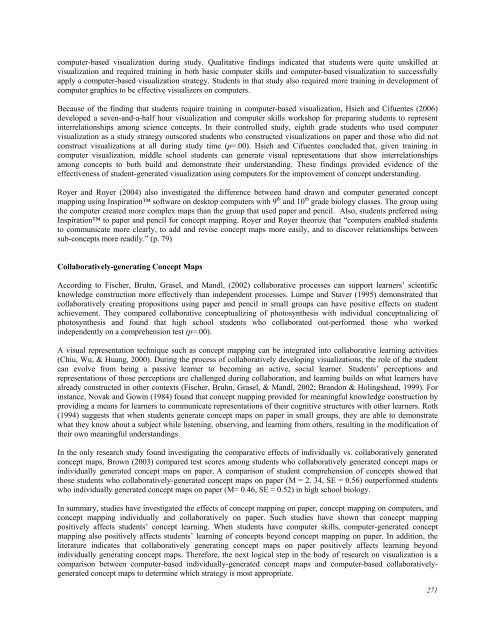October 2007 Volume 10 Number 4 - Educational Technology ...
October 2007 Volume 10 Number 4 - Educational Technology ...
October 2007 Volume 10 Number 4 - Educational Technology ...
You also want an ePaper? Increase the reach of your titles
YUMPU automatically turns print PDFs into web optimized ePapers that Google loves.
computer-based visualization during study. Qualitative findings indicated that students were quite unskilled at<br />
visualization and required training in both basic computer skills and computer-based visualization to successfully<br />
apply a computer-based visualization strategy. Students in that study also required more training in development of<br />
computer graphics to be effective visualizers on computers.<br />
Because of the finding that students require training in computer-based visualization, Hsieh and Cifuentes (2006)<br />
developed a seven-and-a-half hour visualization and computer skills workshop for preparing students to represent<br />
interrelationships among science concepts. In their controlled study, eighth grade students who used computer<br />
visualization as a study strategy outscored students who constructed visualizations on paper and those who did not<br />
construct visualizations at all during study time (p=.00). Hsieh and Cifuentes concluded that, given training in<br />
computer visualization, middle school students can generate visual representations that show interrelationships<br />
among concepts to both build and demonstrate their understanding. These findings provided evidence of the<br />
effectiveness of student-generated visualization using computers for the improvement of concept understanding.<br />
Royer and Royer (2004) also investigated the difference between hand drawn and computer generated concept<br />
mapping using Inspiration software on desktop computers with 9 th and <strong>10</strong> th grade biology classes. The group using<br />
the computer created more complex maps than the group that used paper and pencil. Also, students preferred using<br />
Inspiration to paper and pencil for concept mapping. Royer and Royer theorize that “computers enabled students<br />
to communicate more clearly, to add and revise concept maps more easily, and to discover relationships between<br />
sub-concepts more readily.” (p. 79)<br />
Collaboratively-generating Concept Maps<br />
According to Fischer, Bruhn, Grasel, and Mandl, (2002) collaborative processes can support learners’ scientific<br />
knowledge construction more effectively than independent processes. Lumpe and Staver (1995) demonstrated that<br />
collaboratively creating propositions using paper and pencil in small groups can have positive effects on student<br />
achievement. They compared collaborative conceptualizing of photosynthesis with individual conceptualizing of<br />
photosynthesis and found that high school students who collaborated out-performed those who worked<br />
independently on a comprehension test (p=.00).<br />
A visual representation technique such as concept mapping can be integrated into collaborative learning activities<br />
(Chiu, Wu, & Huang, 2000). During the process of collaboratively developing visualizations, the role of the student<br />
can evolve from being a passive learner to becoming an active, social learner. Students’ perceptions and<br />
representations of those perceptions are challenged during collaboration, and learning builds on what learners have<br />
already constructed in other contexts (Fischer, Bruhn, Grasel, & Mandl, 2002; Brandon & Holingshead, 1999). For<br />
instance, Novak and Gowin (1984) found that concept mapping provided for meaningful knowledge construction by<br />
providing a means for learners to communicate representations of their cognitive structures with other learners. Roth<br />
(1994) suggests that when students generate concept maps on paper in small groups, they are able to demonstrate<br />
what they know about a subject while listening, observing, and learning from others, resulting in the modification of<br />
their own meaningful understandings.<br />
In the only research study found investigating the comparative effects of individually vs. collaboratively generated<br />
concept maps, Brown (2003) compared test scores among students who collaboratively generated concept maps or<br />
individually generated concept maps on paper. A comparison of student comprehension of concepts showed that<br />
those students who collaboratively-generated concept maps on paper (M = 2. 34, SE = 0.56) outperformed students<br />
who individually generated concept maps on paper (M= 0.46, SE = 0.52) in high school biology.<br />
In summary, studies have investigated the effects of concept mapping on paper, concept mapping on computers, and<br />
concept mapping individually and collaboratively on paper. Such studies have shown that concept mapping<br />
positively affects students’ concept learning. When students have computer skills, computer-generated concept<br />
mapping also positively affects students’ learning of concepts beyond concept mapping on paper. In addition, the<br />
literature indicates that collaboratively generating concept maps on paper positively affects learning beyond<br />
individually generating concept maps. Therefore, the next logical step in the body of research on visualization is a<br />
comparison between computer-based individually-generated concept maps and computer-based collaborativelygenerated<br />
concept maps to determine which strategy is most appropriate.<br />
271

















